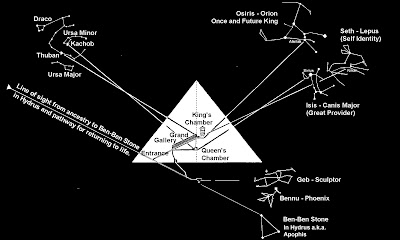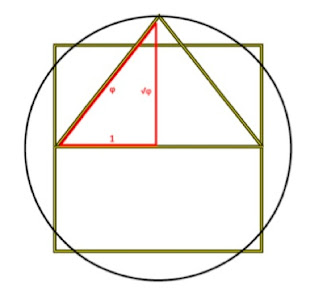The final lesson is about time. The Great Pyramid can teach us great deal about time, with respect to astronomical and astrological synchronicity. It is a tool the Ancient Egyptian priests used that, superimposed against the night sky, allowed them to study the stars and precession of time.
In 1983, a construction engineer named Robert Bauval made a startling observation that the arrangement of the three Giza plateau pyramids mimics that of the three stars of Orion’s belt. What is known as the Orion Correlation Theory suggests the Great Pyramid is correlated with the relative positions of various constellations as they appeared circa 10,5000 B.C. This hypothesis evolved into a great revelation concerning the time-dependant nature of this device – that stars are the clock governing its operation and that the Great Pyramid was probably constructed thousands of years before it’s renovation by Pharaoh Khufu in 2,560 B.C.
Using astronomy simulation software, at about 10,500 B.C. the Great Pyramid’s shafts and passageways would have been directly aligned to constellations that were central to the Ancient Egyptian religion. These are namely the gods Osiris, represented by Orion, Isis, represented by Sirius, Seth, represented by Lepus, Nephthys, represented by Ursa Minor, and Apep, represented by Draco. Furthermore, the constellations of Leo, the Lion, and Virgo, the Virgin, were directly facing the Sphinx at the rising of the Sun. It is this astronomical understanding that leads us to take another step back to study how pyramids all over the word are embodiments of the Hermetic principle, “As above, so below.”
Apart from being a tool inextricably linked to the stars, the Great Pyramid was also used as a giant sundial. The shadows cast by the pyramids against the flat and level ground of the Giza plateau would have been tracked throughout the day, for thousands of years. This explains how the Ancient Egyptians were aware of the precession of the equinoxes. Using the data collected as well as a complex understand of geometry and mathematical algorithms they essentially extrapolated patterns in time.
In this respect, could the pyramid have been an instrument to measure solar activity? Today, NASA satellites STEREO-A & B constantly monitor the Sun for developing sunspots and potential Coronal Mass Ejections (CME’s). Although the Sun follows roughly a 22-year cycle, physicists have proposed that the Sun could undergo major changes like a pole-shift. Periods of violent sun activity would affect our magnetosphere and ionosphere, possibly inducing the necessary AC magnetic field conditions required for pyramids around the world to activate.
The Great Pyramid has withstood the test of time. It is the only remaining ancient wonder of the world. Are pyramids bound to play a larger roll in humanity's future – uniting us under a common understanding? The premise of a “pyramid time,” is exactly that notion – that the Great Pyramid is that uniting factor, silently waiting for the Sun to return so it may spread the love and compassion we so much deserve. Pyramid Time is a forum for discussing the possibility of a natural New World Order.
In 1983, a construction engineer named Robert Bauval made a startling observation that the arrangement of the three Giza plateau pyramids mimics that of the three stars of Orion’s belt. What is known as the Orion Correlation Theory suggests the Great Pyramid is correlated with the relative positions of various constellations as they appeared circa 10,5000 B.C. This hypothesis evolved into a great revelation concerning the time-dependant nature of this device – that stars are the clock governing its operation and that the Great Pyramid was probably constructed thousands of years before it’s renovation by Pharaoh Khufu in 2,560 B.C.
Using astronomy simulation software, at about 10,500 B.C. the Great Pyramid’s shafts and passageways would have been directly aligned to constellations that were central to the Ancient Egyptian religion. These are namely the gods Osiris, represented by Orion, Isis, represented by Sirius, Seth, represented by Lepus, Nephthys, represented by Ursa Minor, and Apep, represented by Draco. Furthermore, the constellations of Leo, the Lion, and Virgo, the Virgin, were directly facing the Sphinx at the rising of the Sun. It is this astronomical understanding that leads us to take another step back to study how pyramids all over the word are embodiments of the Hermetic principle, “As above, so below.”
Apart from being a tool inextricably linked to the stars, the Great Pyramid was also used as a giant sundial. The shadows cast by the pyramids against the flat and level ground of the Giza plateau would have been tracked throughout the day, for thousands of years. This explains how the Ancient Egyptians were aware of the precession of the equinoxes. Using the data collected as well as a complex understand of geometry and mathematical algorithms they essentially extrapolated patterns in time.
In this respect, could the pyramid have been an instrument to measure solar activity? Today, NASA satellites STEREO-A & B constantly monitor the Sun for developing sunspots and potential Coronal Mass Ejections (CME’s). Although the Sun follows roughly a 22-year cycle, physicists have proposed that the Sun could undergo major changes like a pole-shift. Periods of violent sun activity would affect our magnetosphere and ionosphere, possibly inducing the necessary AC magnetic field conditions required for pyramids around the world to activate.
The Great Pyramid has withstood the test of time. It is the only remaining ancient wonder of the world. Are pyramids bound to play a larger roll in humanity's future – uniting us under a common understanding? The premise of a “pyramid time,” is exactly that notion – that the Great Pyramid is that uniting factor, silently waiting for the Sun to return so it may spread the love and compassion we so much deserve. Pyramid Time is a forum for discussing the possibility of a natural New World Order.
















